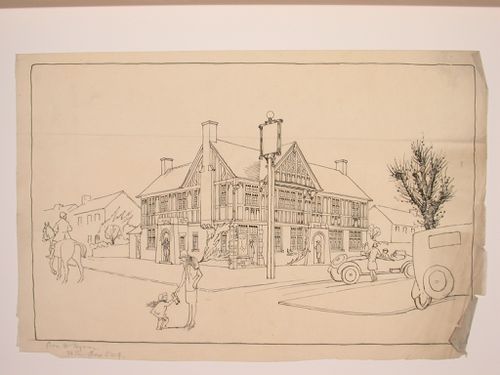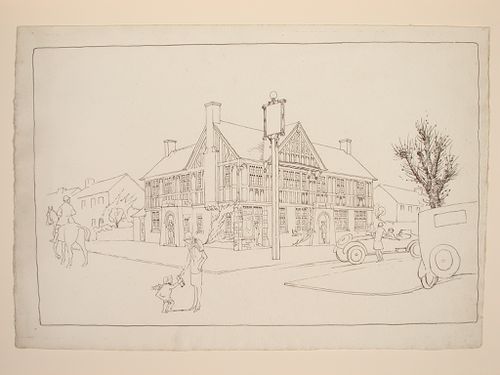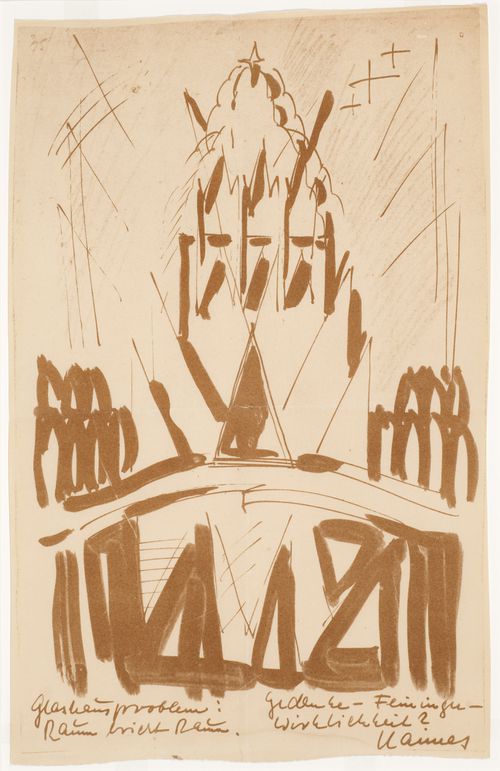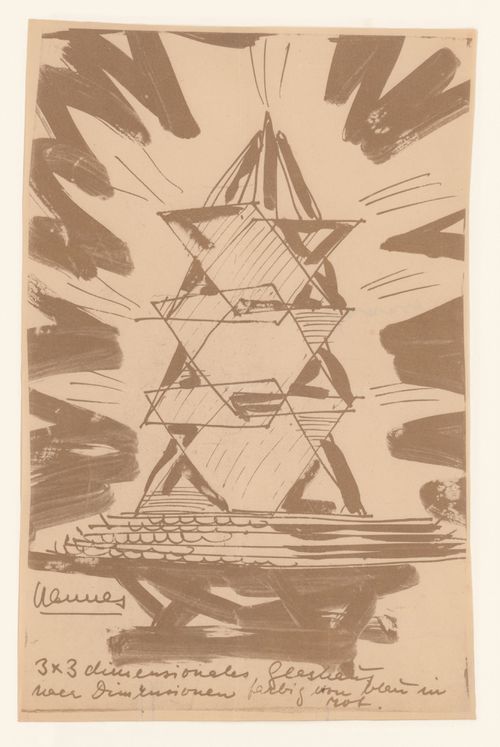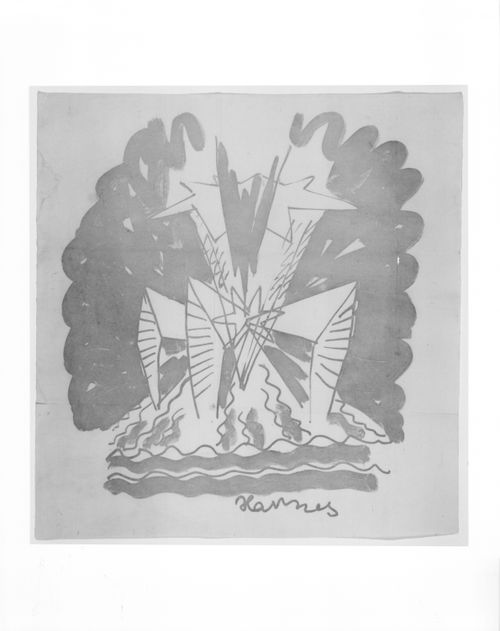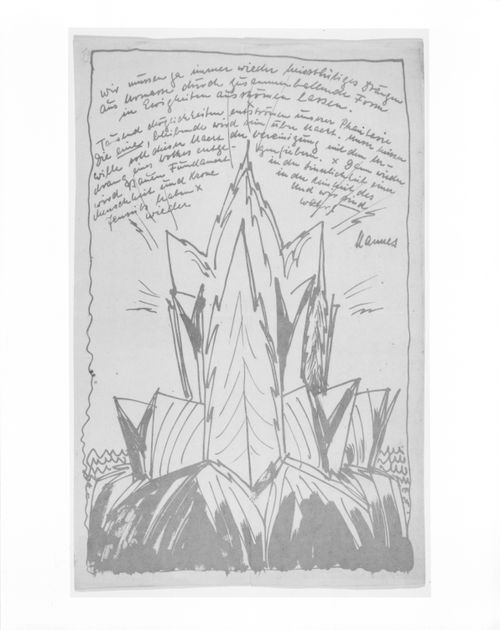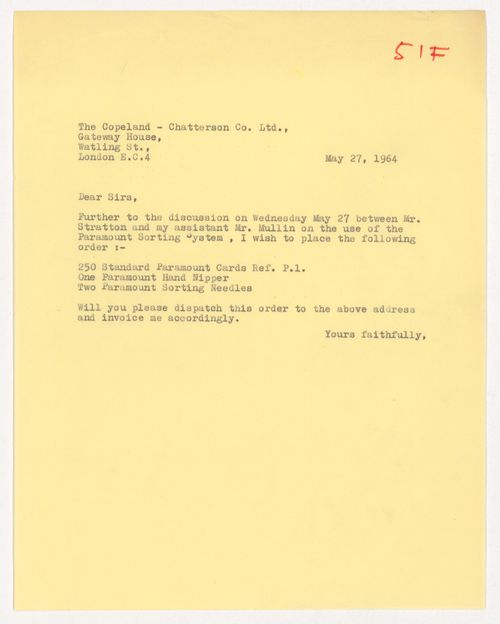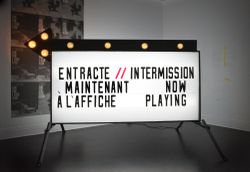textual records
ARCH273413
Description:
Certificate of Honorary Citizen of the City of Taichung, Taiwan. Given to Arthur Erickson in recognition of his achievements; signed by the City's mayor, Lin Po-jung.
25 May 1995
Certificate of Honorary Citizen of the City of Taichung, Taiwan
Actions:
ARCH273413
Description:
Certificate of Honorary Citizen of the City of Taichung, Taiwan. Given to Arthur Erickson in recognition of his achievements; signed by the City's mayor, Lin Po-jung.
textual records
25 May 1995
DR1988:0352
Description:
- This drawing shows a three-storey Tudor Revival building viewed from the street corner. The number of entrances, along with the post for a sign (which is blank) suggest that this building is an inn, or possibly a clubhouse. - The style of many of these drawings and reprographic copies by Henry Hyams (DR1988:0332 - DR1988:0414) suggests that they were possibly for periodical illustrations. Hyams contributed articles to the periodicals 'The Builder' and 'The Architect'. Two objects in the CCA collections can be linked to the article "Music in Stone" published prior to 1926 in 'The Architect'; a reprographic copy (DR1988:0357) and a drawing (DR1988:0364) (Who's Who in Architecture, 161).
architecture
1920s or 1930s
Perspectival view showing a Tudor Revival building, probably an inn or a clubhouse
Actions:
DR1988:0352
Description:
- This drawing shows a three-storey Tudor Revival building viewed from the street corner. The number of entrances, along with the post for a sign (which is blank) suggest that this building is an inn, or possibly a clubhouse. - The style of many of these drawings and reprographic copies by Henry Hyams (DR1988:0332 - DR1988:0414) suggests that they were possibly for periodical illustrations. Hyams contributed articles to the periodicals 'The Builder' and 'The Architect'. Two objects in the CCA collections can be linked to the article "Music in Stone" published prior to 1926 in 'The Architect'; a reprographic copy (DR1988:0357) and a drawing (DR1988:0364) (Who's Who in Architecture, 161).
architecture
DR1988:0353
Description:
- This reprographic copy shows a three-storey Tudor Revival building viewed from the street corner. The number of entrances, along with the post for a sign (which is blank) suggest that this building is an inn, or possibly a clubhouse. - The style of many of these drawings and reprographic copies by Henry Hyams (DR1988:0332 - DR1988:0414) suggests that they were possibly for periodical illustrations. Hyams contributed articles to the periodicals 'The Builder' and 'The Architect'. Two objects in the CCA collections can be linked to the article "Music in Stone" published prior to 1926 in 'The Architect'; a reprographic copy (DR1988:0357) and a drawing (DR1988:0364) (Who's Who in Architecture, 161).
architecture
1920s or 1930s
Perspectival view showing a Tudor Revival building, probably an inn or a clubhouse
Actions:
DR1988:0353
Description:
- This reprographic copy shows a three-storey Tudor Revival building viewed from the street corner. The number of entrances, along with the post for a sign (which is blank) suggest that this building is an inn, or possibly a clubhouse. - The style of many of these drawings and reprographic copies by Henry Hyams (DR1988:0332 - DR1988:0414) suggests that they were possibly for periodical illustrations. Hyams contributed articles to the periodicals 'The Builder' and 'The Architect'. Two objects in the CCA collections can be linked to the article "Music in Stone" published prior to 1926 in 'The Architect'; a reprographic copy (DR1988:0357) and a drawing (DR1988:0364) (Who's Who in Architecture, 161).
architecture
Glashausproblem
DR1988:0020:002
Description:
Reproduction of a drawing of Scharoun published in "Ruf zum Bauen", a publication by the Arbeiterrats für Kunst, in 1920. Drawing signed "Hannes", pseudonym of Scharoun for Die gläserne Kette correspondence.
1919 or 1920
Glashausproblem
Actions:
DR1988:0020:002
Description:
Reproduction of a drawing of Scharoun published in "Ruf zum Bauen", a publication by the Arbeiterrats für Kunst, in 1920. Drawing signed "Hannes", pseudonym of Scharoun for Die gläserne Kette correspondence.
DR1988:0020:003
Description:
Reproduction of a drawing of Scharoun published in "Ruf zum Bauen", a publication by the Arbeiterrats für Kunst, in 1920. Drawing signed "Hannes", pseudonym of Scharoun for Die gläserne Kette correspondence.
1919 or 1920
Drawing of a glass house project by Hans Scharoun
Actions:
DR1988:0020:003
Description:
Reproduction of a drawing of Scharoun published in "Ruf zum Bauen", a publication by the Arbeiterrats für Kunst, in 1920. Drawing signed "Hannes", pseudonym of Scharoun for Die gläserne Kette correspondence.
DR1988:0020:005
Description:
Reproduction of a drawing of Scharoun published in "Ruf zum Bauen", a publication by the Arbeiterrats für Kunst, in 1920. Drawing signed "Hannes", pseudonym of Scharoun for Die gläserne Kette correspondence.
1919 or 1920
Untitled drawings by Hans Scharoun
Actions:
DR1988:0020:005
Description:
Reproduction of a drawing of Scharoun published in "Ruf zum Bauen", a publication by the Arbeiterrats für Kunst, in 1920. Drawing signed "Hannes", pseudonym of Scharoun for Die gläserne Kette correspondence.
DR1988:0020:004
Description:
Reproduction of a drawing of Scharoun published in "Ruf zum Bauen", a publication by the Arbeiterrats für Kunst, in 1920. Drawing signed "Hannes", pseudonym of Scharoun for Die gläserne Kette correspondence.
1919 or 1920
Untitled drawings by Hans Scharoun
Actions:
DR1988:0020:004
Description:
Reproduction of a drawing of Scharoun published in "Ruf zum Bauen", a publication by the Arbeiterrats für Kunst, in 1920. Drawing signed "Hannes", pseudonym of Scharoun for Die gläserne Kette correspondence.
DR1995:0188:747
Description:
The letter is not signed, but it mentions the assistant Mullin. Cedric Price had an assistant named Stephen Mullin from 1964 to 1969. So the letter is presumably written by Cedric Price.
27 May 1964
Letter, possibly from Cedric Price, to Copeland-Chatterson Co. Ltd. regarding the use of the Paramount Sorting System
Actions:
DR1995:0188:747
Description:
The letter is not signed, but it mentions the assistant Mullin. Cedric Price had an assistant named Stephen Mullin from 1964 to 1969. So the letter is presumably written by Cedric Price.
The CCA galleries are transformed into cinematic screening rooms to present a range of artistic, scientific, and experimental films on speed and space. Selected by curators from the archives of NASA, the Smithsonian National Air and Space Museum (NASM), the National Film Board of Canada (NFB), and UbuWeb, the films explore the impact of velocity and technology on our(...)
Main galleries
25 November 2009 to 28 February 2010
Intermission: Films From a Heroic Future
Actions:
Description:
The CCA galleries are transformed into cinematic screening rooms to present a range of artistic, scientific, and experimental films on speed and space. Selected by curators from the archives of NASA, the Smithsonian National Air and Space Museum (NASM), the National Film Board of Canada (NFB), and UbuWeb, the films explore the impact of velocity and technology on our(...)
Main galleries
textual records
DR1988:0023:008
Description:
Letter signed "Glas", pseudonym of Taut for Die gläserne Kette correspondence, written on letterhead of the architectural firm Bruno Taut, Max Taut and Franz Hoffmann, Architekten.
December 4, 1920
Letter from Bruno Taut to Wenkel Hablik
Actions:
DR1988:0023:008
Description:
Letter signed "Glas", pseudonym of Taut for Die gläserne Kette correspondence, written on letterhead of the architectural firm Bruno Taut, Max Taut and Franz Hoffmann, Architekten.
textual records
December 4, 1920
